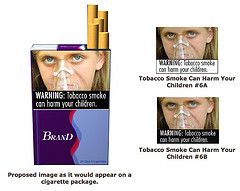 Federal regulators are testing the waters with the first proposed changes to cigarette packaging and advertisements in more than 25 years—bold health warnings with color images that show the tragic consequences of smoking.
Federal regulators are testing the waters with the first proposed changes to cigarette packaging and advertisements in more than 25 years—bold health warnings with color images that show the tragic consequences of smoking.
On Nov. 10, the Food and Drug Administration (FDA) posted on the Internet 36 images showing the dangers of smoking. Federal health agencies hope the new warnings will discourage Americans from smoking by bringing them face-to-face with the cancers that plague smokers.
Under 2009’s Family Smoking Prevention and Tobacco Control Act, cigarette packages and advertisements must carry more pointed health warnings with color images after Sept. 12, 2012. FDA is beginning the process by publishing a proposal in the Federal Register that outlines new packaging and advertising requirements for cigarette makers.
FDA Invites Public Comment
FDA is asking the public to weigh-in on the images. When the public comment period ends on Jan. 9, 2011, FDA will use the comments, research results, and scientific research to pare the list to nine. The final set of images and the congressionally mandated health warnings will rotate on all cigarette packaging and in advertisements by fall 2012.
By law, the nine warnings that must appear on cigarette advertisements and packaging are:
- WARNING: Cigarettes are addictive
- WARNING: Tobacco smoke can harm your children
- WARNING: Cigarettes cause fatal lung disease
- WARNING: Cigarettes cause cancer
- WARNING: Cigarettes cause strokes and heart disease
- WARNING: Smoking during pregnancy can harm your baby
- WARNING: Smoking can kill you
- WARNING: Tobacco smoke causes fatal lung disease in nonsmokers
- WARNING: Quitting smoking now greatly reduces serious risks to your health
Once in place, each warning will accompany a color image, and they’ll be splashed over 50 percent of the front and rear panels of all cigarette packages and at least 20 percent of each advertisement.
Preventable Deaths
If the requirements seem tough, they’re intended to be. The Centers for Disease Control and Prevention says tobacco use is the single biggest cause of preventable death in the United States—killing more than 443,000 users and victims of secondhand smoke and causing serious illness in 8.6 million Americans.
The new warnings will be required on cigarette packages no later than Sept. 22, 2012
Where to See the Warnings and Where to Comment
 To view the warning labels, go to: www.flickr.com/photos/fdaphotos/collections/72157625232230587/
To view the warning labels, go to: www.flickr.com/photos/fdaphotos/collections/72157625232230587/
To submit comments on the warning labels and the proposed rule—between Friday, Nov. 12, 2010, through Tuesday, Jan. 11, 2011:
- Go to www.regulations.gov and insert docket number FDA-2010-N-0568 into the “search” box and follow the prompts.
- Send a fax, with your comments, to 301-827-6870.
- Mail/Hand delivery/Courier (for paper, disk, or CD-ROM submissions) to the Division of Dockets Management (HFA-305), Food and Drug Administration, 5630 Fishers Lane, Room 1061, Rockville, MD 20852.
All comments should be identified by Docket ID No. FDA-2010-N-0568. It is only necessary to send one set of comments.


 Today,more than 200 health professionals attended the
Today,more than 200 health professionals attended the 
 In July, a commentary in the journal
In July, a commentary in the journal